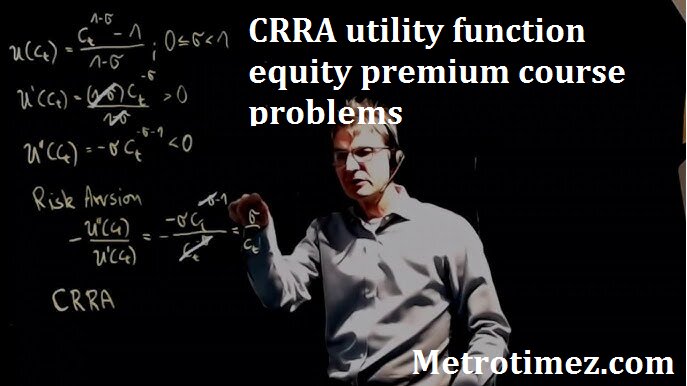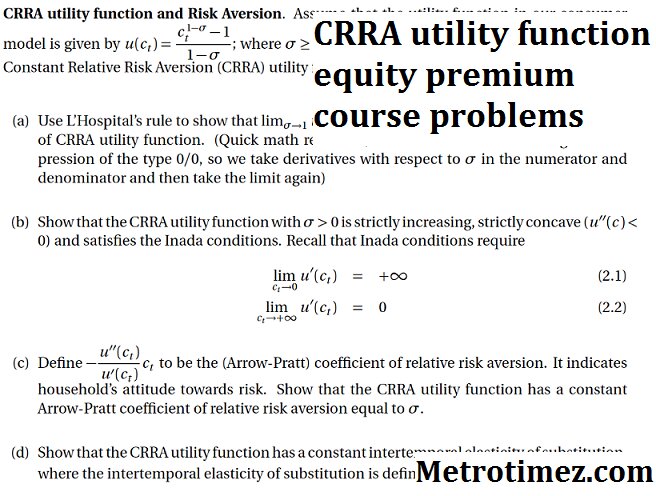
When it comes to understanding financial decision-making, the CRRA utility function equity premium course problems emerges as a critical concept. It bridges the gap between risk and reward in an increasingly complex investment landscape. Whether you’re an aspiring investor or a seasoned finance professional, grasping how this function operates can significantly influence your strategies
Introduction to the CRRA Utility Function Equity Premium Course Problems
Have you ever wondered why some investors are willing to take greater risks for potentially higher returns? Or how changes in wealth affect their decisions? These questions lead us deeper into exploring risk aversion and substitution of wealth—two pivotal elements that shape our financial choices.The CRRA utility function equity premium course problems utility function demystifying these concepts, you’ll gain valuable insights that could impact your future investments and enhance your financial literacy!
Exploring the relationship between risk aversion and willingness to substitute wealth
Risk aversion plays a crucial role in shaping financial behavior. Individuals with high risk aversion tend to prefer stable outcomes over uncertain ones. This preference often limits their willingness to invest in higher-risk assets, even if those assets promise greater long-term returns.
Conversely, an individual’s willingness to substitute wealth reflects how they view the trade-off between current and future consumption. Those who are more open to substituting wealth may take on risks that others shy away from, seeking potential gains rather than sticking with safer options.
This interplay highlights a fascinating dynamic in decision-making processes. A person’s risk tolerance directly influences their investment choices and overall portfolio strategy, ultimately affecting their financial health and growth potential.
Analyzing the interpretation of polar cases in risk-aversion and substitution frameworks

- Polar cases in risk aversion reveal two extremes: complete risk aversion and perfect substitutability. A completely risk-averse individual shuns any uncertainty, prioritizing security over potential gains. This perspective leads to a preference for guaranteed outcomes, often resulting in conservative investment choices.
On the other hand, individuals exhibiting perfect substitutability embrace risks with open arms. They are willing to trade off wealth freely for expected returns without hesitation. In such scenarios, fluctuations in asset prices do not deter their decision-making processes; rather, they actively seek opportunities that promise higher rewards.
These interpretations highlight how different attitudes toward risk influence financial behavior and decision-making strategies. Understanding these polar cases allows investors and analysts to tailor their approaches according to varying levels of risk tolerance within market dynamics.
Effects of price changes in contingent claims on individual choices
Price changes in contingent claims can significantly influence individual decision-making. When the value of these claims shifts, it alters perceived risk and opportunity, prompting investors to reassess their strategies. For instance, a rise in prices may lead individuals to believe that an asset is becoming more valuable, encouraging them to invest further.
Conversely, if prices decline sharply, fear of loss might dominate choices. This reaction often causes investors to withdraw or hedge against potential downturns. The psychology behind such responses reveals much about risk aversion and how individuals allocate resources based on fluctuating market conditions.
Moreover, these price movements can create ripple effects across broader financial markets. Investors react not just based on their own portfolios but also on collective sentiment shaped by changes in contingent claim values. This interconnectedness highlights the dynamic nature of investment decisions influenced by real-time market data.
Calculating the value of ‘R’ and required average return
Calculating the value of ‘R’ in the context of the When it comes to understanding financial decision-making, the CRRA utility function equity premium course problems emerges as a critical concept. It bridges the gap between risk and reward in an increasingly complex investment involves understanding individual preferences toward risk. This parameter directly affects how investors perceive potential gains and losses. By determining an individual’s level of risk aversion, we can derive a specific value for ‘R’, which scales with their willingness to endure fluctuations in wealth.
Next, assessing required average return is crucial for making informed investment decisions. Investors often seek returns that align with their risk tolerance levels. The relationship between ‘R’ and expected returns helps shape expectations around asset performance over time.
This calculation empowers investors to make better choices aligned with their financial goals while considering market risks. Recognizing these dynamics aids individuals as they navigate complex investment landscapes.
Key Concepts related to CRRA Utility Function Equity Premium Problems
The CRRA utility function equity premium course problems is foundational in understanding how individuals derive satisfaction from wealth over time. It emphasizes constant relative risk aversion, meaning that as wealth increases, the proportionate attitude toward risk remains unchanged. This concept helps in modeling investor behavior and preferences.
Equity premium refers to the excess return that investing in stocks provides over a risk-free rate. It reflects investors’ compensation for taking on additional risk associated with equity investments. The interplay between this premium and the CRRA utility function equity premium course problems offers valuable insights into optimal asset allocation.
Understanding these key concepts can aid financial professionals and students alike in tackling complex problems related to investment strategies. Grasping how changes in market conditions impact perceptions of risk and reward is essential for effective decision-making within financial frameworks.
Addressing common questions surrounding the CRRA Utility FunctionEquity Premium Course Problems
CRRA utility function equity premium course problems often raises questions among students and practitioners alike. One common query involves its assumptions about risk aversion. Many wonder how a constant relative risk aversion model can accurately reflect real-world behaviors, especially when individuals display varying degrees of risk tolerance over time.
Another frequent concern pertains to the implications of the equity premium puzzle. People ask why historical returns on equities consistently exceed those predicted by models using the CRRA utility function equity premium course problems. This invites further exploration into behavioral finance and market dynamics that may not align with traditional economic theories.
Additionally, learners often seek clarity on practical applications of CRRA utility function equity premium course problems in portfolio optimization. They want to understand how this theoretical construct translates into actionable in CRRA utility function equity premium course problems vestment strategies that balance risks and rewards effectively within their financial plans.
Practical Application of CRRA Utility Function Equity Premium Course Problems in Financial Decision-Making
The CRRA utility function equity premium course problems is a powerful tool in financial decision-making. It helps investors understand their risk tolerance and how they perceive changes in wealth. By quantifying preferences for consumption over time, the CRRA framework allows individuals to make informed choices regarding investments.
For instance, an investor with higher risk aversion may opt for safer assets even if it means lower returns. Conversely, someone willing to take risks might pursue equities that offer a potential equity premium. This understanding also aids in portfolio construction and asset allocation strategies tailored to specific goals.
Real-world applications can be seen in retirement planning or saving for major life events where understanding future consumption needs is crucial. Additionally, by analyzing various scenarios using the CRRA Utility Function Equity Premium Problems model, investors can gauge the impact of market fluctuations on their portfolios.
In finance education settings, incorporating CRRA utility function concepts into course problems fosters deeper comprehension among students. They learn not just theoretical aspects but practical implications as well—preparing them for challenges they’ll face in real markets effectively.